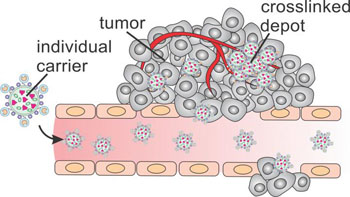Nanocarriers Deploy Enzymes for Targeted Delivery of Anticancer Drugs
By LabMedica International staff writers
Posted on 08 Feb 2016
A newly devised nanocarrier delivery system transports a combination of anticancer and anti-angiogenesis drugs to the site of a tumor where the acidic environment releases them to damage the cancer cells and deprive them of nutrients by blocking creation of new blood vessels.Posted on 08 Feb 2016
In the January 19, 2016, online edition of the journal Nanoletters investigators at the University of North Carolina (Chapel Hill, USA) described a “transformable” core–shell based nanocarrier (designated CS-NG), which could enzymatically assemble into microscopic extracellular depots at the site of a tumor.

Image: Biomedical engineering researchers have developed a technique for creating microscopic “depots” for trapping drugs inside cancer tumors. In an animal model, these drug depots were more effective at shrinking tumors than the use of the same drugs without the depots (Photo courtesy of Quanyin Hu, University of North Carolina).
The nanoparticles (approximately 100 nanometers in diameter) consisted of a liposomal core and a cross-linked gel shell containing human serum albumin (HSA). A cocktail comprising the anti-cancer drug TRAIL (tumor necrosis factor-related apoptosis-inducing ligand) and the anti-angiogenesis drug cilengitide was trapped in the aqueous core of the particles. A series of smaller nanoparticles (only 10 nm in diameter) made of a hyaluronic acid gel and containing the enzyme transglutaminase (TG) were attached to the surface of the larger particles.
The rationale for the design of such a complicated construct was that tumors produce large quantities of the enzyme hyaluronidase, which degrades hyaluronic acid. Therefore, when the nanocarriers reach the neighborhood of the tumor, the enzyme would dissolve the small hyaluronic acid gel nanocapsules and release the TG enzymes inside. These would trigger cross-linking of the HSA proteins on the surface of the nanocarriers and create a cross-linked drug depot within the tumor microenvironment. The size of the cross-linked depots would help to prevent them from being absorbed by individual cancer cells or from being dislodged by the bloodstream. Finally, the acidic tumor microenvironment would act to break down the nanoparticles and release the trapped drugs to act on the nearby cancer cells.
Experiments that incorporated the nanocarriers revealed enhanced cytotoxicity on MDA-MB-231 cancer cells growing in culture and improved antitumor efficacy in mice, which was attributed to the inhibition of cellular internalization and prolonged retention time in vivo.
"This is a proof-of-concept study and additional work needs to be done to develop the technique," said senior author Dr. Zhen Gu, assistant professor of biomedical engineering at the University of North Carolina. "But it is promising, and we think this strategy could also be used for cancer immunotherapy. We would need to do more work in an animal model before pursuing clinical trials."
Related Links:
University of North Carolina













